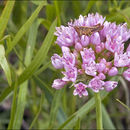en
names in breadcrumbs


Allium angulosum, the mouse garlic, is a species of garlic native to a wide region of central Europe and northern Asia, from France and Italy to Siberia and Kazakhstan.[3][4]
Allium angulosum is a perennial herb up to 50 cm tall. Bulbs are narrow and elongated, about 5 mm in diameter. The plant produces a hemispherical umbel of small pink flowers on long pedicels.[4][5]
Allium angulosum is cultivated as an ornamental and also as an herb for kitchen gardens. Bulbs and leaves are edible cooked or in salads. There are, however, some reports of being toxic in large quantities.[6]
Allium angulosum, the mouse garlic, is a species of garlic native to a wide region of central Europe and northern Asia, from France and Italy to Siberia and Kazakhstan.
Allium angulosum is a perennial herb up to 50 cm tall. Bulbs are narrow and elongated, about 5 mm in diameter. The plant produces a hemispherical umbel of small pink flowers on long pedicels.